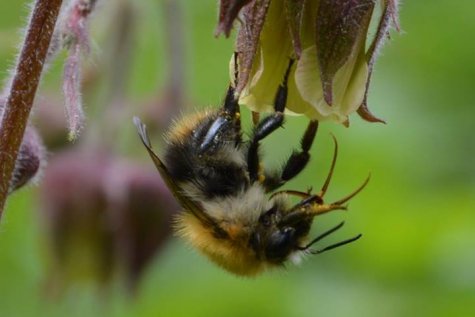Home rules for bumblebee families
Text Reet Karise and Marika Mänd
Photo Veronika Jarošenko
Translation: Liis
Common carder bee (Bombus pascuorum)
A social way of life means family living where division of labour has a very important role. In the bumblebee family there is one mother who is engaged in egglaying; in addition there is a number of widowers or males who generally do not participate in the family doings; their role is to fertilize the young mothers. A large part of the family members are workers who normally do not reproduce but contribute to the upbringing of their siblings. Why is the reproductive function, the most important task for a living organism, waived?
Reproduction means the transmission of genes to the next generation. Since the sisters have the same genes to 50%, a part of the genes will reach the next generation also by the breeding success of another. Any single bee or ant has a very large probability of being eaten before it manages to produce offspring. Thus bees have divided labour so that the one who has very large energy reserves and who never goes out or puts herself at risk will deal with egg-laying. Others however do everything to ensure that this individual will be able to lay eggs.
The larvae of bumblebees are fed regardless of their caste with similar food which mainly consists of pollen and nectar. The caste is determined by the frequency of feedings in the final stages of larval development: females are fed more often than workers.
Bumblebee families are still at a more primitive social level than for instance honeybee families. Bumblebees have no workers in spring, thus the female herself has to exit from the nest. When the first generation of worker bees come out the queen will no longer leave the nest. Bumblebees have a division of labour based on both age and morphology. The domestic workers are smaller and younger individuals. Their tasks include caring for the eggs, ventilating the nest and keeping the temperature. The brood cell is made by the queen herself. The task of the external workers is to collect pollen and nectar. Nectar is collected by the largest external workers, the medium sized collect both nectar and pollen and the smallest external workers only collect pollen. Which of these is collected most depends on the needs of the family. If collecting workers are lost they are replaced from the domestic workers.
At the end of the week summer warmth is expected. Please review the previous articles:
Identification pages for bumblebees: LINK (in Estonian)
Guidelines for observing bumblebees and questionnaire: LINK (in Estonian)
Web questionnaire for bumblebees: LINK (in Estonian)
Take part in observing bumblebees and join the „Meie kimalased (Our bumblebees)“ group on Facebook: LINK









